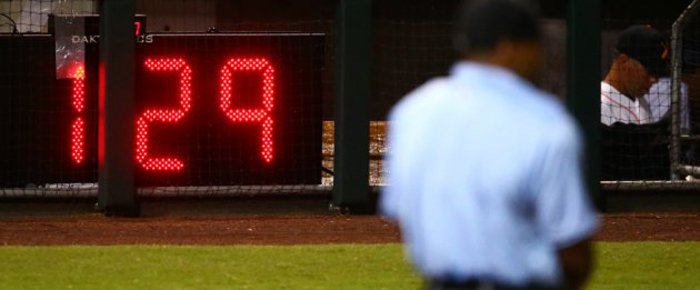
By Flint Wheeler
With the average Major League Baseball game soaring past three hours despite decreasing offensive numbers in the game, the league announced Monday that it will test out various experimental rule changes during Arizona Fall League play to improve the sport’s pace.
They include some dramatic changes, like eliminating the need to actually throw four balls to intentionally walk a batter, and some obvious ones, like limiting the amount of time a pitcher can take between pitches.
The full list of rules to be tested is as follows, from a Major League Baseball press release:
1. Batter’s Box Rule: “The batter shall keep at least one foot in the batter’s box throughout his at-bat, unless one of a series of established exceptions occurs, in which case the batter may leave the batter’s box but not the dirt area surrounding home plate.”
2. No-Pitch Intentional Walks: “In the event a team decides to intentionally walk a batter, no pitches shall be thrown. Instead, the manager shall signal to the home plate umpire with four fingers, and the batter should proceed to first base to become a runner.”
3. 20-Second Rule: (To be used only at AFL games played at Salt River Fields) “A modified version of Rule 8.04, which discourages unnecessary delays by the pitcher, shall apply. Rule 8.04 requires the pitcher to deliver the ball to the batter within 12 seconds after he receives the ball with the bases unoccupied. The penalty prescribed by Rule 8.04 for a pitcher’s violation of the Rule is that the umpire shall call ‘Ball.’
“In the AFL games at Salt River, a clock will be displayed in both dugouts, behind home plate, and in the outfield. The clock will be operated by an independent operator, who is not a member of the umpire crew. A pitcher shall be allowed 20 seconds to throw each pitch…. The clock will stop only when the pitcher begins his motion to deliver the ball (and not ‘when the pitcher releases the ball’ as prescribed in Rule 8.04). Beginning the motion of coming to the set position shall be sufficient to stop the clock. If the pitcher maintains possession of the ball without beginning his pitching motion for more than 20 seconds, the Umpire shall call ‘Ball.’”
4. 2:05 Inning Break Clock: “There shall be a maximum 2:05 break between innings. Hitters must enter the batter’s box by the 1:45 mark. When batters violate this rule, the Umpire may call an automatic strike. When batters are set by the appropriate time and pitchers fail to throw a pitch before the conclusion of the 2:05 period, the Umpire shall call a ball.”
5. 2:30 Pitching Change Break Clock: “There shall be a maximum 2:30 break for pitching changes, including pitching changes that occur during an inning break. The first pitch must be thrown before the conclusion of the 2:30 period or the umpire shall call a ball. The clock shall start when the new pitcher enters the playing field (i.e., crosses the warning track, or foul line).”
6. Three “Time Out” Limit: “Each team shall be permitted only three ‘Time Out’ conferences per game (including extra innings). Such conferences shall include player conferences with the pitcher (including the catcher), manager or coach conferences with the pitcher, and coach conferences with a batter. Conferences during pitching changes, and time outs called as a result of an injury or other emergency, shall not be counted towards this limit. A manager, coach or player will not be permitted to call a fourth time out in violation of this Rule. In such cases, the game will continue uninterrupted, and offenders may be subject to discipline.”
Great! None of the proposed changes interfere at all with actual gameplay. No one’s talking about shortening games to seven innings or changing the strike zone or limiting pitching changes.
Of the six rules above, the last looks most likely to prove controversial among players and coaches. Though it makes sense to limit the number of mound conferences, it seems like the pitch clock might have the same effect. And the first time a catcher loses a breaking ball in the dirt because of confusion over signs with runners on base, you will inevitably hear griping about his inability to sync up with the pitcher beforehand.
The no-pitch intentional walk rule will look funny to anyone who hasn’t seen it used in an amateur game. But though throwing the intentional balls does sometimes provide an offensive team opportunity to advance on the bases, but ultimately, who cares? Intentional walks will always be a necessary strategy at certain points in the game, and no one’s watching baseball to see a fireballing reliever try his best to lob four straight pitches five feet off the plate.
Oh Baseball. Please allow some of these changes to stick. If the experiment in Fall-ball does well and actually sticks in this upcoming MLB season, I’d be surprised.











































